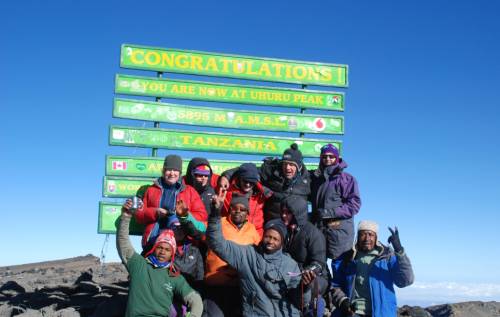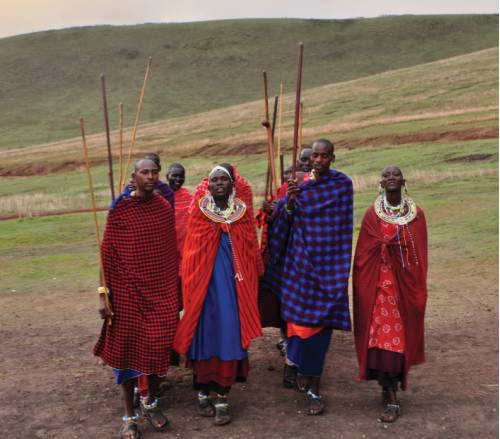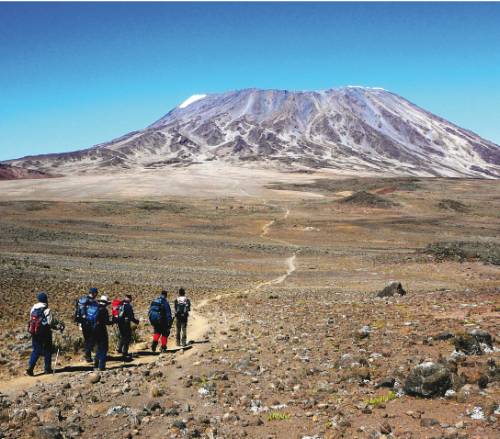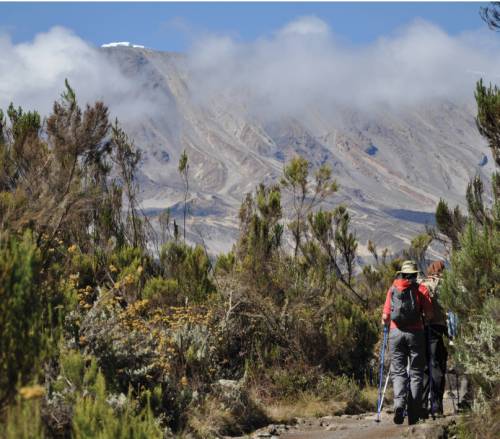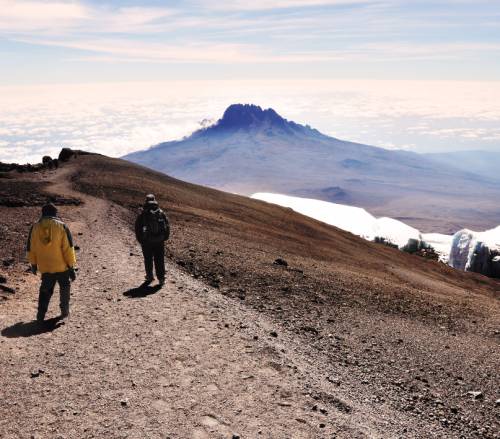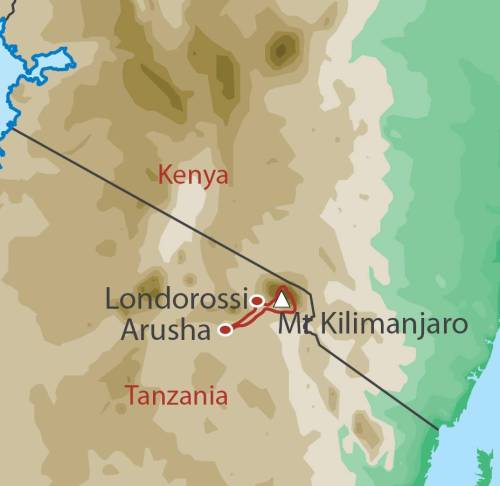Kilimanjaro - Remote Northern Circuit
Kilimanjaro - Remote Northern Circuit
$4539
Kilimanjaro - Remote Northern Circuit
11 Days Starting and ending in Arusha
Visiting: Tanzania
Tour Overview
Climbing the highest mountain in Africa on the Northern Circuit route is a draw card for any avid trekker, but especially with a full moon summit! Mt Kilimanjaro (5895m), fondly known as Kili, being a free-standing mountain commands panoramic views of the surrounding plains. Having nine days to acclimatise and encountering limited numbers of fellow trekkers, this route is truly remote and one for the trekking enthusiast. Commencing from the western side, catch a glimpse of Mt Meru floating on the clouds from the Shira Plateau before traversing the less visited northern flanks to enjoy fabulous vistas across vast Kenyan lowlands. Then, approaching the summit from the east in the light of the full moon, experience the tremendous feeling of space generated before standing on the top of Africa. Finally, a descent to the south completes an almost-circumnavigation of the mountain. This less-visited northern route provides opportunity for a truly remarkable adventure to the top of Kilimanjaro.
Highlights
Itinerary
Day 1 : Join Arusha, Trip Briefing
Today is an arrival day. If you choose to fly into Kilimanjaro Airport we recommend a private transfer to Arusha where the rest of the day is at your leisure. (With prior arrangement, airport pick up and private transfers to the hotel are available from Kilimanjaro International Airport (JRO), or simply make your own way by taxi. Note that taxis are scarce after about 18:00hrs. We stay at Moivaro Coffee Plantation which has spacious rooms, a pool, and restaurant. This afternoon at 16:30, you will meet the rest of the group and your guide for a trip briefing.
Day 2 : Drive To Lemosho Gate, Commence Climb To Lemosho Big Tree Camp (2,650 M)
After completing the necessary registration formalities, we drive through varied farmland with open views over the plains to reach the Lemosho Gate roadhead. The last section of the road is of poor quality and difficult to drive after rain, sometimes we start walking a kilometre or two below the roadhead. We often have our lunch at the roadhead before starting to walk. It is an easy day of walking up a small path through beautiful and lush forest. We camp at Lemosho Big Tree Camp (2,650 m); [2-3 hours walking]
Day 3 : To Shira One Camp (3550M)
We soon leave the forest behind and enter the moorland zone of giant heather. The trail climbs steadily with wide views to reach the rim of the Shira Plateau. There is a tangible sense of wilderness, especially if afternoon mists come in! We camp in the centre of the plateau at “Shira One” (3,550 m). [6-7 hours walking]
Day 4 : To Shira Hut Camp (3840M)
We walk to the summit of Shira Cathedral before reaching the next camp at Shira Hut (3,840 m). This campsite has stunning views, close to the glaciated dome of Kibo and the jagged rim of Shira Plateau. The views from here of Mt. Meru floating on the clouds are simply unforgettable. [5-7 hours walking]
Day 5 : To Moir Hut (4200M)
In the morning we follow the main trail up to Lava Tower, and for those feeling strong there is a possibility to climb up to the ruined hut at Arrow Glacier around 4,800m. We then continue from Lava Tower to reach our campsite at Moir Hut (4,200m). [5-7 hours walking]
Day 6 : To Buffalo Camp (4,150M)
We climb out of the Moir Valley and take a short detour to reach the summit of Little Lent hill at 4,375 metres. After admiring the views we return to the trail and head eastwards around the northern circuit trail. Here the trail passes through a field of rock slabs that clink as they are walked on. The final section of today's walk undulates until reaching the location of Buffalo Camp (4,150m). At the camp there is a huge feeling of space as the Kenyan plains stretch out far below to the north. [4-7 hours walking]
Day 7 : To Third Cave Camp (3,900M)
From Buffalo Camp we climb up to the top of 'Buffalo Ridge' and drop down the other side to reach Pofu, nearby the is a small spring and some vegetation. The trail continues eastwards through a landscape that has increasingly sparse vegetation to eventually reach Third Cave Camp (3,900m). [5-7 hours walking]
Day 8 : To School Hut Campsite (4,700M)
There is a steady ascent to reach The Saddle, a lunar landscape between the peaks of Kibo and Mawenzi. From here we continue upwards and reach School Hut Campsite (4,700m) in the early afternoon. The remainder of the afternoon is spent resting and preparing for the summit day. [4-5 hours walking]
Day 9 : Summit Day (5,896 M) To Millenium Camp (3,800 M)
We will start our ascent by torchlight at about midnight so that we can be up on the Crater rim by sunrise. On selected Non-Exclusive departure dates each month, the climb will be particularly beautiful as we ascend in the light of the Full Moon. The steep climb over loose volcanic scree has some well-graded zig-zags and a slow but steady pace will take us to Gilmans Point (5,685 m) in about five or six hours. We will rest there for a short time to enjoy the sunrise over Mawenzi. The trail leads west along the crater rim to Uhuru Peak (5,896 m), passing close to the spectacular glaciers and ice cliffs that still occupy most of the summit area. We retrace our steps along the crater rim to Stella Point and then descends down through Barafu Camp to reach Millenium Camp (3,800 m). [11-15 hours walking]
Day 10 : Descend To Mweka, Then To Arusha
A sustained descent on a well constructed path through lovely tropical forest alive with birdsong and boasting lush undergrowth with considerable botanical interest. Our route winds down to the National Park gate at Mweka (1,650 m). Here we sign out from the national park before walking on for a further 15 minutes through coffee and banana farms to Mweka village where our vehicle awaits. The shower, the beer, and the swimming pool are tantalizingly close! [4-6 hours walking]
Overnight: Moivaro Coffee Plantation
Day 11 : In Arusha, Trip Concludes
In Arusha, after breakfast at your hotel, the trip arrangements end.
What's Included
-
10 breakfasts, 9 lunches and 10 dinners
-
Park entrance fees approx. US$1251
-
Private vehicle transport between Arusha and Mt Kilimanjaro
-
Accommodation in 3 star hotel in Arusha
-
All group camping and catering equipment on the Kilimanjaro climb (sleeping bags and mats are not provided)
-
Experienced mountain guides, cook and camp crew
-
Porters to carry personal equipment
-
Emergency oxygen
-
International or domestic flights
-
Arrival or departure transfers in Arusha
What You Carry
In your daypack you will need to carry extra warm clothing (depending on the altitude, location and weather), a rainjacket, water bottle, camera gear, valuables and personal items such as sunscreen, lip balm etc.
Grading
As with all our Moderate to Challenging programs, we expect clients to be regular outdoors people, enjoying aerobic sport around three to four times a week over some period of time. Preferably this has been a long term interest but if not, you have set a program of fitness preparation with at least three months lead in time to your trip. The fitter you are for your trip, the more of a holiday it will be. Activities as close to the actual activity on your trip are the best training; in this instance hill walking, with and without a daypack. This builds leg strength, aerobic capacity and confidence in your ability to travel comfortably with a pack for extended periods. At the same time, you are also comfortable with the layers you like to wear and footwear.
Whilst this ascent of Kilimanjaro is not a technical climb, it is nevertheless a short and steep trek at altitude, and for many people it will be the hardest physical walk of their life. In order to get the most out of the trip, people should join in Arusha with a maximum state of fitness. There is not time to ‘get fit on the trek’ as with some of our other longer trekker programs elsewhere.
Come and talk to us if you are unsure about your suitability for this route; we would be happy to discuss your level of experience and fitness with you and put you in touch with one of our guides to help you make your decision.
Check out our Q&As
-
Who will be my travelling companions on the tour?
We have offices on three continents which means your travelling companions will be just that – international and wonderfully eclectic. Part of small group travel means that although travellers come from various locations and backgrounds, you will be travelling with like-minded companions who, like you, are keen to share the experience and forge lifelong friendships.
-
What about environmental impact?
We believe that adventure travel revolves around establishing a strong relationship with the people and environments in which we operate. Our responsible travel policies have been carefully developed to ensure that we minimise the impact of our presence and help to protect the regions we visit while contributing positively to the local community.
-
What should I pack?
Your pre-departure documents include a detailed packing list with items that you need to bring. While most of the equipment for daily activities is included in your tour cost, some items like helmets and hiking boots are best brought from home. The pre-departure documents also include information on layering and recommended brands for various items to ensure you are fully prepared for your trip.
-
Do you operate a “single share” option and how does it work?
Yes. World Expeditions does not require single travellers to pay a surcharge for travelling alone on the vast majority of our trips. Our holidays are primarily on a twin share basis, so if you are joining the group as a solo traveller, we will match you with someone of your own gender. The choice is yours however; if you prefer not to share, we do offer single supplements for private occupancy.
-
Are tips included in my trip price?
Tips are not included in the tour cost. Tipping is a personal thing, do not worry about how much, or when, to tip. Tipping guidelines are provided for certain destinations in our pre departure information upon booking, however the best advice will be provided by your tour leader.
-
Am I suited to small-group travel?
We recognise that many of our travellers have not been on a ‘group trip’ before. Yet what our departures provide is both structure and flexibility, allowing you plenty of freedom within the framework of the itinerary. You’ll find that with our maximum group size at 16, you’ll travel in a minimal impact style with a great group of like-minded travellers.
-
Can you advise which vaccinations are recommended?
While our pre-departure kit provides information on vaccinations, we suggest that you consult your doctor, local government inoculation centre or a travel medical specialist in order to get the most current advice regarding vaccination requirements.
Reviews from travellers on this tour
1 Select your preferred date
Sunday - Wednesday
Dec 08, 2024 - Dec 18, 2024Monday - Thursday
Jan 06, 2025 - Jan 16, 2025Wednesday - Saturday
Feb 05, 2025 - Feb 15, 2025Friday - Monday
Mar 07, 2025 - Mar 17, 2025Tuesday - Friday
Jul 01, 2025 - Jul 11, 2025Thursday - Sunday
Jul 31, 2025 - Aug 10, 2025Friday - Monday
Aug 29, 2025 - Sep 08, 2025Sunday - Wednesday
Sep 28, 2025 - Oct 08, 2025Thursday - Sunday
Dec 25, 2025 - Jan 04, 2026Saturday - Tuesday
Jan 24, 2026 - Feb 03, 2026Sunday - Wednesday
Feb 22, 2026 - Mar 04, 2026Book with Confidence
-
Transfer as credit to Future Tours
World Expeditions allows you to transfer existing payments to a future tour to avoid cancellation fees if you can't travel and inform world expeditions, 70 days before departure.
-
Low Deposit
World Expeditions requires a minimum deposit of 400 GBP per person or the full booking value, whichever is less, with the final balance not due until 70 days before departure.
-
Cancellation Policy
We don't charge a cancellation fee, here is a summary of world expeditions charges.
Up to 70 days before tour starts: Forfeit 100% of deposit.
At 69 days before tour starts: Forfeit 50% of booking price.
At 35 days before tour starts: Forfeit 100% of booking price.
